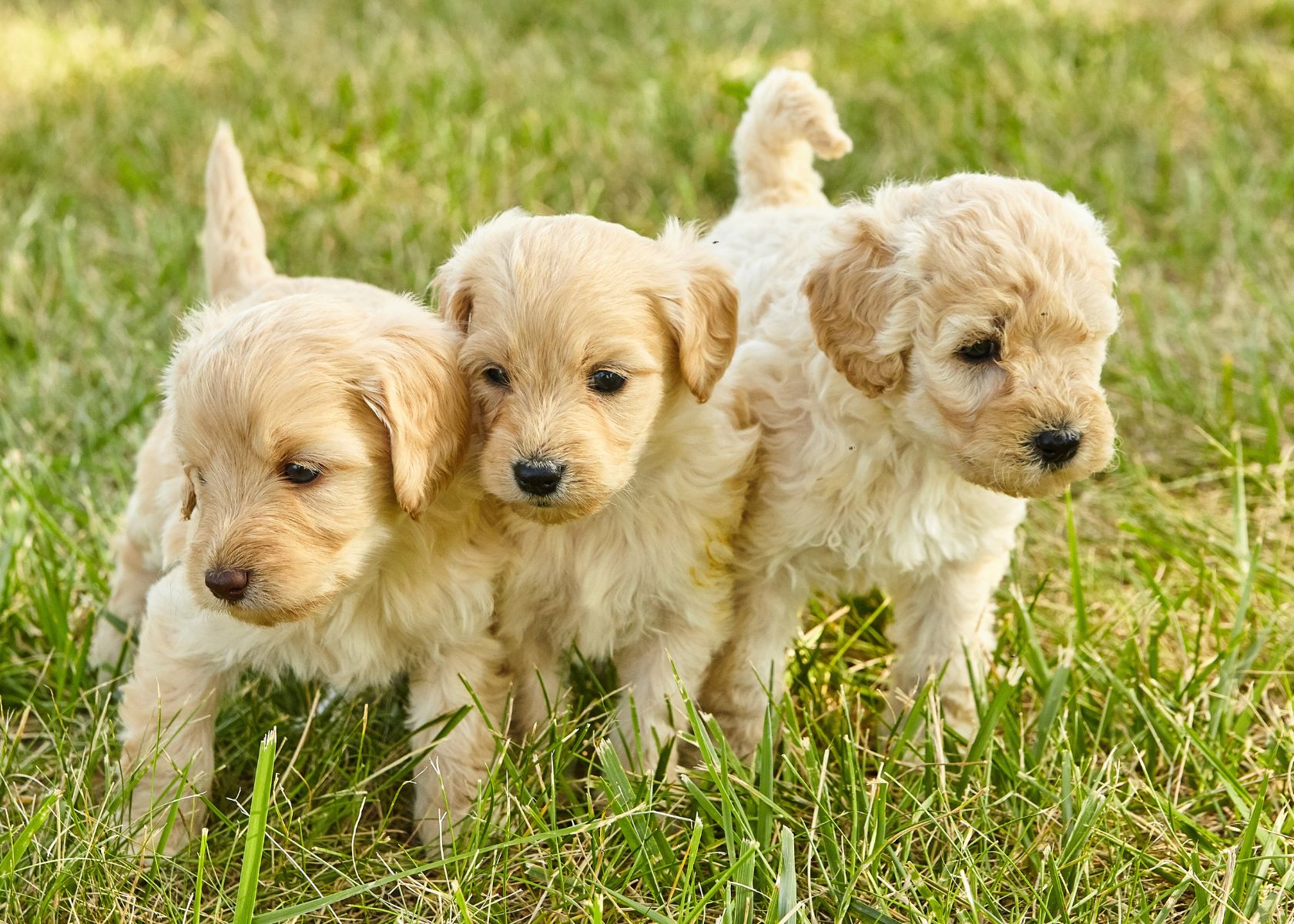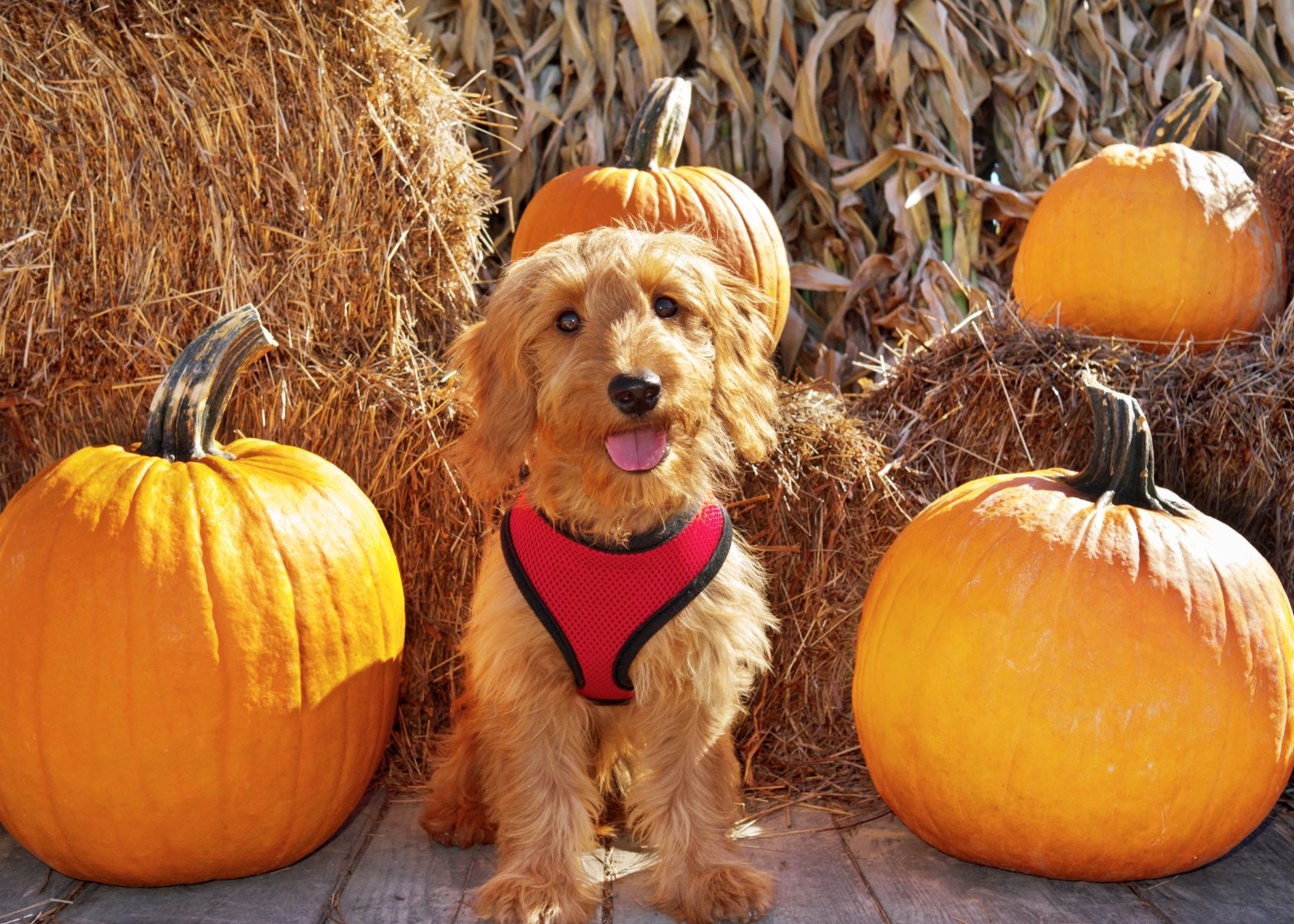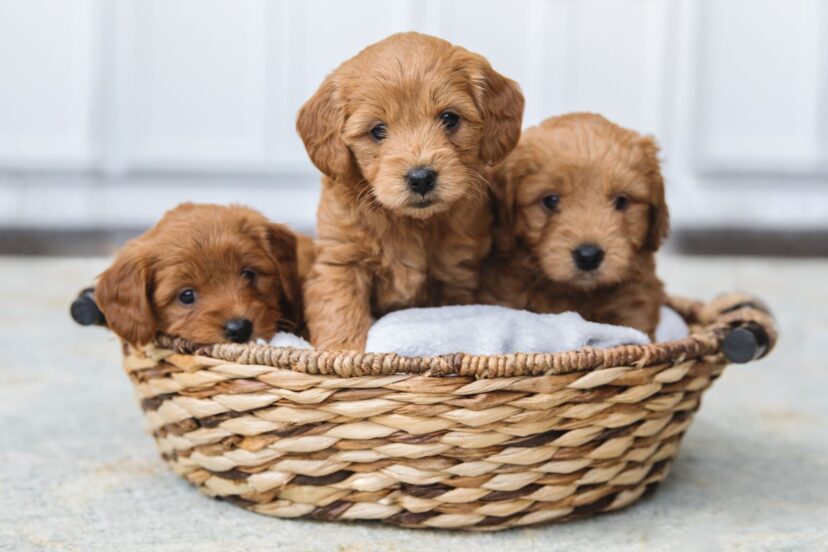How Many Puppies Do Goldendoodles Have? Goldendoodle Litter Size
Have you ever wondered how many puppies do Goldendoodles usually have? With an average litter size of three to eight, these adorable dogs are known for having some surprisingly large families.
In this article, we will delve into all the key factors influencing a Goldendoodle’s litter size, from their breed and health status to their environment.
Don’t miss this insightful guide if you’re considering becoming a proud parent of a fluffy Goldendoodle brood.
Factors Affecting Goldendoodle Litter Size

The size of the dam and the generation of the mini Goldendoodle can impact the number of puppies in a litter.
Size of The Dam
The size of the female Goldendoodle, also known as the dam, contributes to how many puppies she can carry. Larger dams can usually accommodate larger litters in comparison to smaller ones.
For instance, standard Goldendoodles are likely to have 3 to 8 puppies due to their substantial size. On the other hand, Miniature and Toy variants offer fewer puppies because of their compact stature and body capacity.
This differentiation is essential for potential breeders or pet owners aiming at having a clear insight into Goldendoodle reproduction rate and expected canine offspring numbers.
Generation of The Goldendoodle
Goldendoodles are bred by crossing a Golden Retriever with a Poodle. The generation of the Goldendoodle plays a role in determining litter size. F1 Goldendoodles, which are first-generation crosses between a purebred Golden Retriever and a purebred Poodle, tend to have larger litters compared to higher-generation Goldendoodles.
This is because F1 Goldendoodles inherit more genetic diversity from their parent breeds, resulting in increased fertility and larger litter sizes. So if you’re looking for more puppies in each litter, considering an F1 doodle might be the way to go.
Diet and Health of The Dam
The diet and health of the dam play a significant role in determining the litter size of Goldendoodles. A well-balanced diet that is rich in essential nutrients supports optimal reproductive function in female Goldendoodles.
It is important for the dam to be in good overall physical condition, as this can positively impact her fertility and increase the chances of having a larger litter. Additionally, regular exercise and maintaining a healthy weight are vital factors that contribute to the overall health and well-being of the dam, which can ultimately affect the number of puppies she has.
Ensuring proper nutrition and providing necessary veterinary care will help maximize the potential for larger litter size.
Age of The Dam
The age of the dam, or the female Goldendoodle, can have an impact on the litter size. Generally, younger dams tend to have smaller litters, while older dams may experience a decrease in fertility and produce fewer puppies.
It is important for breeders to consider the ideal age for a Goldendoodle to have their first litter and when to stop breeding them to ensure the health and well-being of both the dam and her puppies.
Environmental Factors
Environmental factors can also influence the size of a Goldendoodle’s litter. Factors such as temperature, humidity, and overall stress levels in the environment can impact the number of puppies born.
Additionally, exposure to toxins or pollutants may affect the health and fertility of the dam, potentially resulting in smaller litter. Creating a calm and comfortable environment for breeding can help ensure healthier pregnancies and larger litters for Goldendoodles.
Average Goldendoodle Litter Size

Typically, standard Goldendoodles have an average litter size of six to eight puppies, while miniature Goldendoodles usually have 3 to 8 puppies, and toy Goldendoodles tend to have 2-4 puppies.
Standard Goldendoodles: 6-8 Puppies
Standard Goldendoodles typically have litters of 6 to 8 puppies. This is the most common litter size for this breed. However, it is important to note that the number of puppies can vary and range from as few as 2 or as many as 12 in some cases.
Goldendoodles tend to have larger litter compared to other large breeds, with poodles averaging around 6 puppies per litter and golden retrievers averaging around 8.
Miniature Goldendoodles: 4-6 Puppies
Miniature Goldendoodles typically have litters of 4 to 6 puppies. While this is slightly smaller than the average for other types of Goldendoodles, it still provides a healthy number of adorable puppies to love and care for.
Keep in mind that the actual litter size can vary depending on various factors, such as the size and health of the dam, genetics, and environmental conditions. So if you’re considering breeding or adopting a miniature Goldendoodle, be prepared for a sweet bundle of joy with a smaller but still delightful litter size.
Toy Goldendoodles: 2-4 Puppies
Toy Goldendoodles typically have litters of 2 to 4 puppies. These adorable small-sized pups are known for their playful and affectionate nature. While they may have fewer puppies compared to other sizes of Goldendoodles, each one is just as charming and full of personality.
If you’re looking for a small size of a Goldendoodle, a toy Goldendoodle might be the perfect fit for your family.
Breeding Considerations

Breeding considerations for Goldendoodles include determining the ideal age for a Goldendoodle to have its first litter, knowing when to stop breeding a Goldendoodle, and understanding the weaning age for goldendoodle puppies.
Ideal Age for A Goldendoodle to Have Their First Litter
Goldendoodles should ideally have their first litter between the ages of 2 and 3 years old. It is important to wait until they are fully mature both physically and mentally before breeding them.
This ensures that the dam is in optimal health and can handle the demands of pregnancy and giving birth. Breeding a Goldendoodle too early can increase the risk of complications for both the mother and puppies.
Waiting until they reach the appropriate age helps to ensure a successful breeding experience.
When to Stop Breeding a Goldendoodle?
Goldendoodles should generally stop breeding around the age of six to eight years old. It is important to consider the health and well-being of the female Goldendoodle when making this decision.
Continuing to breed beyond this age can put unnecessary stress on their bodies and increase the risk of complications during pregnancy and delivery. By retiring them from breeding at an appropriate age, we can ensure that they enjoy a happy and healthy retirement.
Weaning Age for Goldendoodle Puppies
Goldendoodle puppies are typically weaned from their mother’s milk when they are around six to eight weeks old. This is the age at which they begin to eat solid food and become more independent.
Weaning is an important milestone in a puppy’s development, as it helps them transition from relying solely on their mother’s milk to getting all the necessary nutrients from a balanced diet.
During this time, it is crucial to provide them with appropriate puppy food and ensure that they have access to clean water at all times. Gradually decreasing the number of nursing sessions while introducing solid foods will help make the weaning process smoother for both the puppies and their dam.
Other Factors Impacting Litter Size

Factors such as a stressful environment, genetics, inbreeding, and the method of insemination can also impact the litter size of Goldendoodles. Read on to learn more about these factors and their effects on Goldendoodle litter.
Stressful Environment
A stressful environment can impact the litter size of Goldendoodles. Stress can be caused by various factors, such as loud noises, constant disturbances, or an unstable living situation.
When a female Goldendoodle is exposed to a stressful environment during pregnancy, it can lead to smaller litters with fewer puppies. This is because stress can affect the hormonal balance and overall health of the mother dog, impacting her reproductive system.
Therefore, it’s important to provide a calm and peaceful environment for your older dog during pregnancy to ensure healthy litter sizes.
Additionally, stress in the early stages of puppy development can also have negative effects on their growth and well-being. It’s crucial to create a nurturing and stress-free environment for both the mother dog and her puppies after birth.
Genetics
Genetics also play a role in determining the litter size of Goldendoodles. The genes passed down from the parents can influence how many puppies a female Goldendoodle will have. While there is no exact formula to predict litter size based on genetics, it is known that certain breeds tend to have larger litter than others.
For example, Poodles average about 6 puppies per litter, while Golden Retrievers tend to have around 8 puppies. Since Goldendoodles are a mix of these two breeds, their litter sizes often fall somewhere in between.
It’s important for breeders to consider the genetic background of their dogs when planning a breeding program and managing expectations for litter sizes.
In addition to genetics, other factors like size, health, and environment can also impact the number of puppies a female Goldendoodle will have. Breeders should ensure that both the male and female dogs undergo thorough health screenings and are in optimal physical condition before breeding them.
Inbreeding
Inbreeding, or the mating of closely related individuals within a breed, can have significant effects on the litter size of Goldendoodles. It is generally recommended to avoid inbreeding as it can lead to reduced fertility and smaller litter sizes.
Inbred Goldendoodles are more likely to have complications during pregnancy and may produce fewer puppies compared to non-inbred individuals. Maintaining genetic diversity through outcrossing with unrelated dogs is crucial for ensuring healthy and robust litters in Goldendoodles.
Method of Insemination
Standard poodle can be bred through two main methods of insemination: natural breeding or artificial insemination. Natural breeding involves allowing a male and female Goldendoodle to mate naturally, either under supervision or in a carefully controlled environment.
This method is favored by some breeders who believe it provides the best chance for successful conception. On the other hand, artificial insemination involves the collection of semen from a male Goldendoodle and introducing it into the reproductive tract of a female Goldendoodle using specialized techniques.
Artificial insemination can offer more control over timing and ensure genetic diversity by allowing breeders to use semen from high-quality males located far away. Both methods have their pros and cons, but ultimately, they both play a crucial role in ensuring successful reproduction among Goldendoodles.
Frequently Asked Questions
How many puppies do Goldendoodles typically have?
Mini Goldendoodles typically have a litter size ranging from 4 to 8 puppies, although it can vary.
Can goldendoodles have larger litter?
Yes, it is possible for Goldendoodles to have larger litters, but it is less common. Some Goldendoodles may have up to 10 or more puppies in a litter.
Are there any factors that can affect the number of puppies a goldendoodle has?
Yes, various factors can influence the number of puppies a goldendoodle has, including genetics, the age of the dog, and overall health.
What should I expect during the birthing process if my goldendoodle is having puppies?
During the birthing process (or whelping), you can expect your Goldendoodle to experience contractions and eventually give birth to each puppy individually. It’s important to provide a calm and comfortable environment while closely monitoring your dog’s progress.
Conclusion
Goldendoodles can have varying litter sizes, ranging from as few as one to as many as twelve puppies. Factors such as the size and generation of the Goldendoodle, diet, and health of the mother, age, and environmental factors can all impact litter size.
Standard Goldendoodle typically has larger litters of around 7-8 puppies on average. However, it is important to note that each individual dog may vary in their reproductive capabilities.




